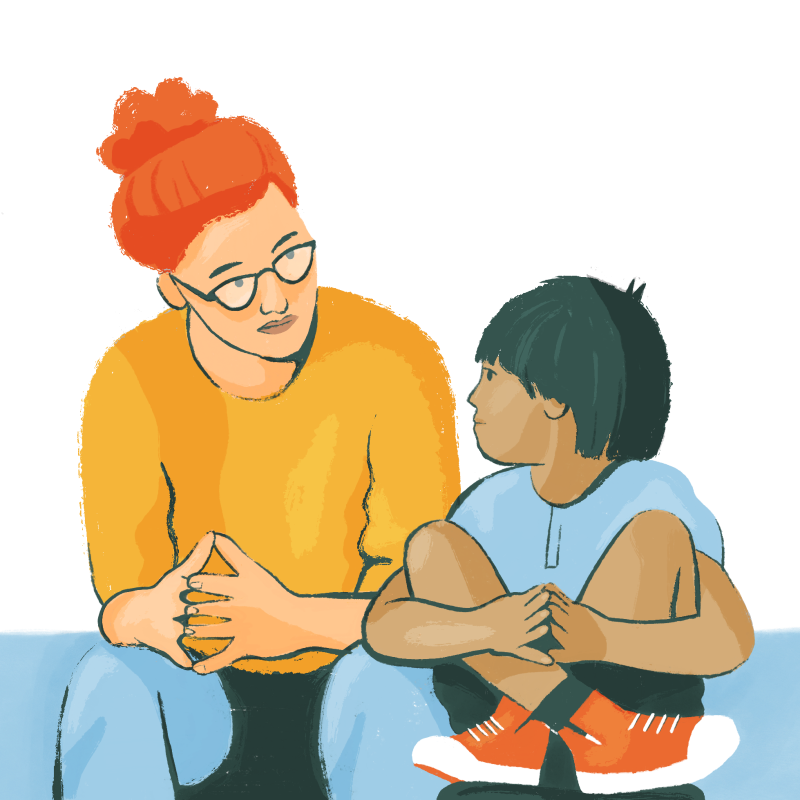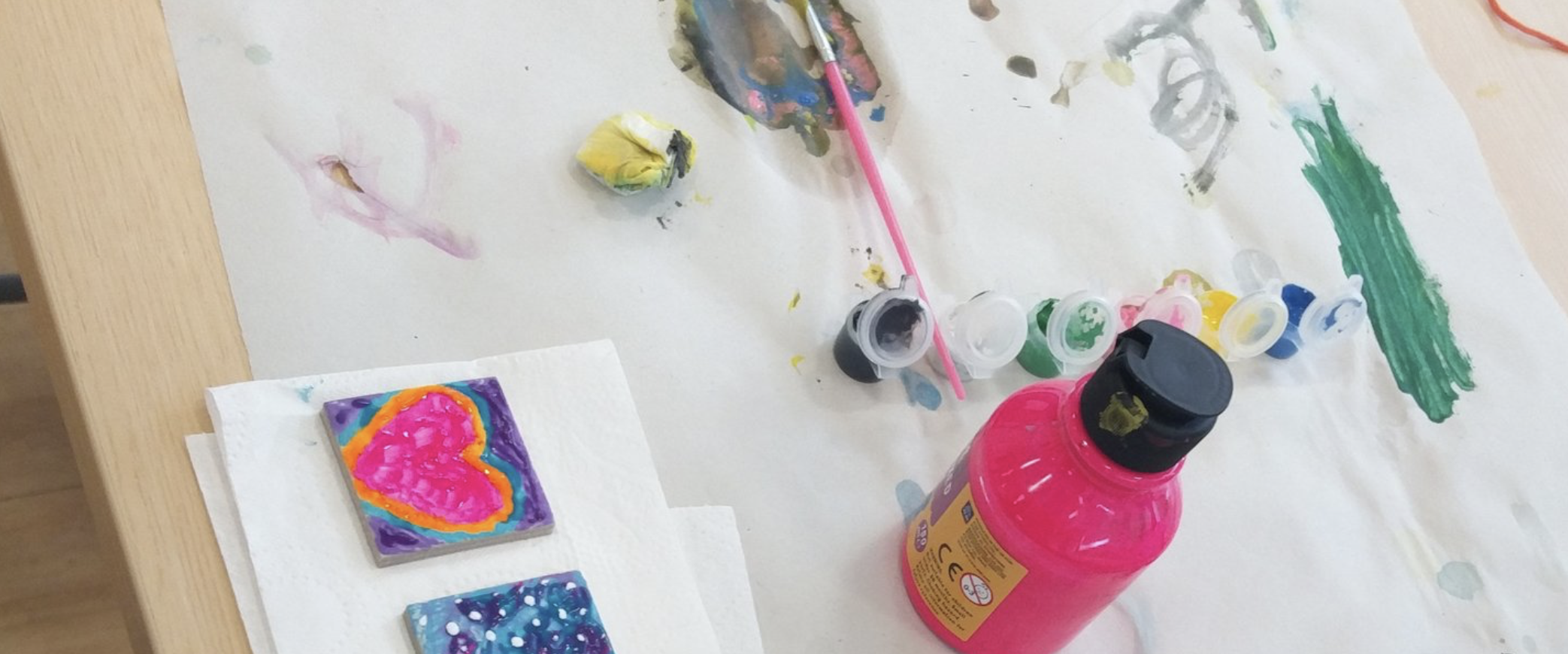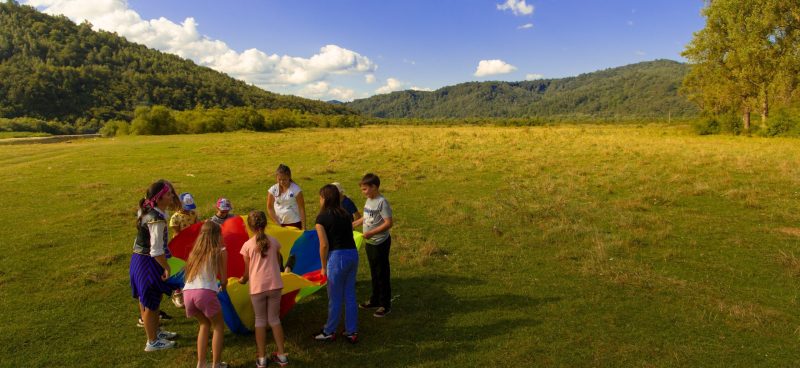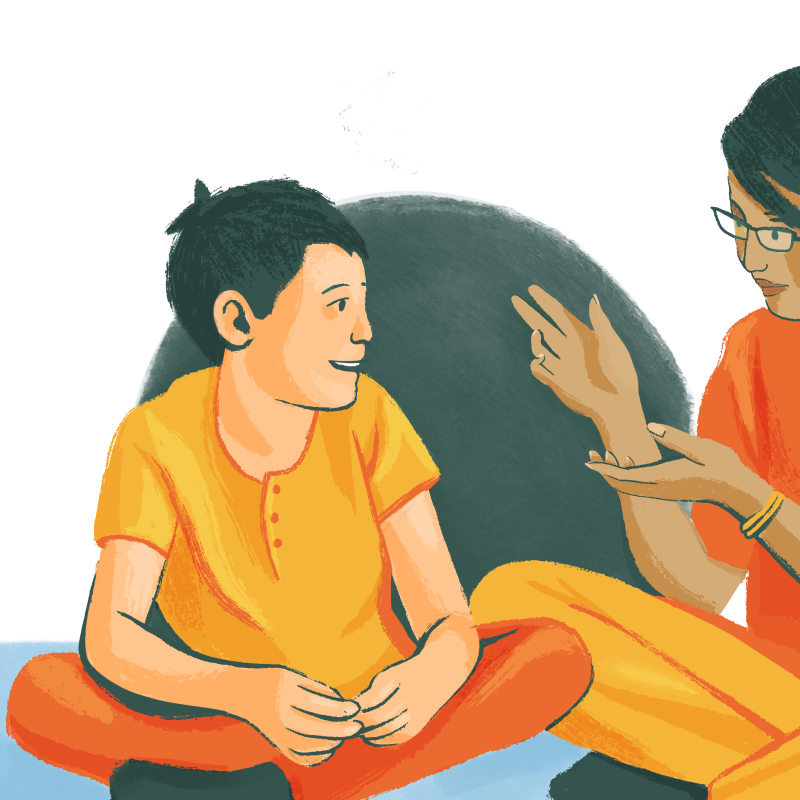
Counselling
Counselling support for young people.

We all know domestic abuse can have a devastating impact on children and young people.
At TLC: Talk, Listen, Change we work with young people affected by domestic abuse, in a variety of ways. We believe that all children deserve access to support, the opportunity to talk about what they’re going through and the chance to sometimes, just be kids. We also believe that all children have the right to safe, healthy, happy relationships in their lives. It’s thanks to the dedication of our experienced and passionate staff that we can provide this support. I decided to sit down and interview two of them – Hollie and Nafeesa.
At the time of writing Hollie Wimpenny was in the position of Children & Young People’s Youth Worker, and Nafeesa Javed in the role a Children & Young People’s Counsellor and the Programme Manager for our Wigan Project, which offered counselling to Children and Young People who had experienced domestic abuse. (Please note these staff members no longer work for the organisation, and the Wigan project has come to a close. Current support can be found here.)
***
Can you both tell me a little bit about yourself and when you started working with children affected by domestic abuse?
Hollie: I’m a part-time youth worker for TLC. I started working with young people probably about 5 years ago as a youth support worker and then it just kinda developed from there. I’m also a drama practitioner and I do a lot of creativity projects with young people as well, with different scenarios.
Nafeesa: I’ve been a children and young people’s counsellor for about 6 years. I’ve worked for TLC for about 5 years and three years ago I started working with children who had witnessed or experience domestic abuse which is very intensive – counselling those children every week. I’m now also running the counselling service in Wigan.
Could you both just tell me the age range of the children you work with who are affected by domestic abuse?
Hollie: Probably ages 6-14.
Nafeesa: The counselling ranges from the age of 5 up until 19 so it ranges, obviously the style of counselling as well, but we see them in the schools or the centres or the colleges.
Could you tell me, Hollie, a little a bit about what happens in the group project? Do you run them by yourself? Are they done in a centre? Do they do visits?
Hollie: So I run a session with another Youth Worker. The activities we do with them very much comes from their interests and what they like. Most of the time they don’t really know what that is so it can be quite difficult. In Oldham we have a kitchen, so they’re really into cooking at the moment, which is great, and baking and things like that. In Stockport they love competition, they love games, board games as well. We’ve got ‘Frustration’ and literally every week we play that, I’m always surprised they just want to play that again and again. We also go out onto visits, in holidays or half terms we always try and take them out and give them new experiences and have fun.
Nafeesa, what is it that you do with the children in the counselling room?
Nafeesa: It depends on the child, it’s completely child-led. Our focus as a counsellor is completely person centred, it’s whatever the client wants to do. When the child that comes through the room with a background of domestic abuse, we go right off the bat saying – “We know this has happened. We know that you’ve had conflict within the home, you’ve seen arguments or heard arguments, we don’t have to talk about it if you don’t want to, we can work on any other area you want to because obviously you are upset or worried or scared about something, that’s why someone has asked us to come out and see you.” And that ranges – we can do creative arts, play therapy, talking therapy. I might read a story or do the same thing they do every week because it’s predictable for them unlike their home environment, which is completely and utterly unpredictable.
Is it typical that the child will want to discuss what’s going on with them in regards to domestic abuse or do you find that actually they really don’t and they want to engage with other things?
Hollie: From my perspective, obviously it’s different for every child, but with youth work and the nature of youth work is that we’re building trusting relationships with them, so what we’ve found is that over time they do start talking about stuff that has happened to them, but it can take a while. But it’s great that they feel safe enough maybe just to give us a few little details of what they’re experiencing and how they’re feeling and then we just go back into play. We don’t ask them questions or force them to tell me anything that they might not want to.
Nafeesa: What’s really important for children and young people who have witnessed domestic abuse is, like what Hollie was saying, to build that trust and rapport with you, especially with counselling because it’s 1 to 1. It’s making sure that they have enough trust and to actually believe their story. They have seen it and witnessed it, no-one else can see it through their eyes so when they’re telling that story they are 100% in that element of wanting to be believed. Also as a therapist, it’s about being an appropriate adult in their lives that understands and believes their story.
Is it masked by other things and you have to get through those layers?
Nafeesa: I’ve found with therapy that some children don’t want to talk about it at all and aren’t ready to address it and some children are ready to dive in straight away because they know that you’re there and are aware of the conflict at their home so will go and tell you the story.
What is the best bit about your job and what is the worst bit?
Hollie: The best bit for me, is obviously every week, my main aim is to have fun with them, so I have fun with the activities. Like we’ve gone to Blackpool Pleasure Beach and even though it’s exhausting, they’re really enjoyable and just seeing them have fun as well, seeing them laugh and smile is probably the best part of the job.
The challenging part is that I’ve got a group of young people who have all experienced domestic abuse in some way, they all have complex needs, and so it’s sometimes challenging having them all together in one group and they do sometimes fight with each other, name call each other. So that can be challenging because sometimes they just don’t get on or issues have come up, sometimes we’ve had to take up further action with parents and stuff like that.
Nafeesa, what’s the best bit?
Nafeesa: Definitely seeing the sometimes really slow progression with children because you get to really know them and see a different side to them. The challenge of that is that no-one else may see that, so you’re completely client centred and working with that particular child and the teacher is saying one thing, the school is saying another, the parents are saying another thing.
I think the challenging part of a project like this is maintaining those particular boundaries for that child and sometimes you are really limited in what you can offer the child. So for therapy, it’s great but it doesn’t last forever so we do have limits to what we can offer. Sometimes they close off every other service working with the child and the family and we are the only ones that are holding up these particular children. When you suddenly become a family support worker and domestic abuse support worker and also the child’s teaching assistant, it’s really trying to hold those boundaries and it’s such a shame because the system really does let them down and we have to hold that for them.
When you say progress, what kind of progress are they making?
Nafeesa: So I’m talking minimal, for example the child in the first 3, 4 weeks doesn’t even make eye contact with you but by week 6 they’re making eye contact. I’m talking being able to build that trust because they’re not used to being around an adult that they feel safe around so small progress like that. Or if they’re able to accept the situation they’re in if they’re older, saying we know life at home is rubbish but how can we keep you safe?
What issues are these children dealing with and how are they affected? Are these children being abused or are they witnesses to the abuse in their homes?
Nafeesa: Both, from my experience..
Hollie: See I don’t really get told their backgrounds, I don’t really know what’s happened in their homes so you obviously have a better understanding of that, unless they tell me personally so for me it’s just having that expectation that it could be anything and maybe anything could set this child off. I don’t know what mood they’re going to be in today I just have to be prepared for all of it.
Nafeesa: If they’re currently being abused that is obviously something we have to take further as part of safeguarding but with domestic abuse you’re going to see viscous cycles occurring. So you might see a protective parent who is still on the scene and the perpetrator, who should no longer be on the scene or if they’re trying to make it work there are still abusive tendencies that are part of the home. Sometimes the protective parent becomes the perpetrator or the child sometimes becomes that perpetrator to fill in that gap that was there before.
Wow.
Nafeesa: Yeah, yeah we’ll see that. We’ve seen that happen a lot.
The cycle of perpetrator abuse?
Nafeesa: So yeah they’ve either witnessed it, experienced it themselves, seen it themselves, heard it themselves. Parents often think that the child wasn’t home or the child was asleep but the child is hearing everything. Sometimes when the child is hearing things rather than seeing things, it can be so much worse because they’re imagining and filling those gaps that the child can’t physically see so it can be a lot worse.
From this experience, which can be chaotic and traumatic, as I said, there can be what we call ‘cycles of abuse’ or the official term we understand it to be is the “drama triangle” playing out in the child’s life.
This is when the original victim of the abuse (in our case it is often the mothers), are so used to being abused by the perpetrator (in our cases often the Mother’s Partner), that once the perpetrator is removed from the child’s life, the victim often but unconsciously looks to “fill that gap” of abuse as such, and often the child is “pushed into” the perpetrator role. This type of interaction can also play out where the original victim becomes the perpetrator and the child then becomes the victim! This is just one example of a type of destructive interaction that can occur between people in conflict, which is often what plays out in the therapy room with the children we see.
Why aren’t these children in care, if there’s abuse? If mum and dad are fighting or if there’s violence towards them? Are these children in the care system or are we just surrounded by children in homes where there is domestic abuse at every turn and the children are within the homes?
Nafeesa: From my experience there have been very few children that are part of the care system. It is there and they either have care orders and social services is still part of that parental responsibility, I’ve had experiences of that. I’ve also seen it where they’re in and out of the care system, so they might make progress at home and we’ve helped them with that bridge back home and settling back in. But the majority of the time it is that they are experiencing it within their home environment, but they’re just not at that threshold yet to be removed possibly because the protective parent has got enough support in place to recover from that.
So social services and care services may be involved in a lot of cases but the child isn’t in the care system, is that right?
Hollie: I think a lot of the young people that come to our groups are either living with their mum or living with their dad, they’re not living together. A lot of them have social workers and a few of them are living in a refuge.
What is the difference between children and young people affected by domestic abuse do you feel and other children? Do you think it changes them?
Hollie: Yeah.
Nafeesa: Yeah 100%.
In what ways?
Nafeesa: I find, when I’m counselling young people who haven’t experienced domestic abuse, their story is completely valid too but just the scale of their stories seems very much around themselves. With children who have experienced domestic abuse, they come with so many more layers – there’s guilt, there’s trauma, there’s self-esteem issues, issues about being the protective ones for their mums, or the guilt around the father not being in their homes, relationship issues, the cycle of abuse that they become the perpetrators, the anger… oh my gosh and the list just goes on. The complexities might be wider than children who possibly haven’t experienced domestic abuse. Their web is a lot bigger.
Would you agree Hollie?
Hollie: Yeah I would definitely agree.
Because you’ve worked with children who haven’t experienced domestic abuse but have other complex issues you said? Do you see a difference?
Hollie: Yes. I also work with children who haven’t experienced anything so I definitely see a difference in them and children that have experienced something, whether that’s domestic abuse or something else. But just being a young person is hard anyway, the brain is still developing and going through puberty and trying to find who you are and what your identity is, you’ve got all that going on as well as the trauma of what they’ve experienced and it’s just a minefield of, like you said, anger, really low self-esteem, being lonely, not really having any friends, that’s why the youth group is so important for some of them.
Do different kinds of domestic abuse affect children in different ways do you think?
Nafeesa: I think either/or the boundaries are going to be blurred. I think the child, in my experience, in the counselling room, will display lack of boundaries in one form or another. They don’t know about time, they don’t know about space boundaries. Sexual abuse and physical abuse, all of that abuse is an invasion of their boundaries, someone’s overstepped the mark with that particular person or they’ve seen or somehow experienced that. I’ve found that with coercive and controlling behaviour, the emotional abuse with older children it somehow seems to affect them, especially girls, a lot more. But physical abuse is something that is completely traumatic as well. I don’t think there is a clear cut answer to that, I think every element of abuse is abuse and every element is horrific and every child will display behaviours and be affected by whatever it is that they’ve experienced and express it differently.
What do you wish the parents, both the perpetrator and the victim or survivor, knew about how it’s affecting their child?
Nafeesa: I think just to be aware that it is affecting their child, has affected their child or is going to affect their child in so many ways if it’s not addressed.
Hollie: Yeah I agree. And in ways that you can’t even predict in the future.
What else could be done to support children and young people affected by domestic abuse? Is more needed? Is something different needed?
Nafeesa: Yeah, because abuse is still occurring. Domestic abuse is absolutely massive and it’s still happening, it’s everywhere. It’s not just in certain cultural homes, it doesn’t discriminate at all and there needs to be more awareness raised. Teachers spend the most time with children, they spend 6 hours out of their day with those particular children, I think there needs to be more training for teachers to be made aware of those particular issues that are popping up for them. There might be attachment issues that are popping up, children need to be protected from that in some form or another, they should not be experiencing or witnessing the stuff they’ve seen because it affects them for the rest of their lives.
Hollie: Yeah and there’s massive cuts to this type of work, especially in youth work. It’s really difficult, there’s not really a lot going on anymore. If a young person knows they can’t talk to a teacher and can’t turn to someone in their family, who else is there?
Nafeesa: And maybe training the family members about what abuse actually is. There needs to be something, possibly for younger children, about what a healthy relationship is. From a young age they need to be aware of what is okay and what is not okay and just getting the parents and family members involved for them to decide what is okay and what is not okay because some family members will not be aware of that. There needs to be more awareness raised that the children are affected by this type of thing, there is always more that can be done.
What do the children enjoy most about the group work and counselling?
Hollie: They definitely enjoy the trips. Every week they’re asking when we’re going on the next trip because they want to do something different and something new. Just being away and knowing they’re in a safe space where they can be themselves and have fun, being a little bit weird, little bit crazy. Just being a kid.
Nafeesa: I think the children just love having that 1-1, quality hour with an adult that will listen and accept and not judge them. They probably don’t get that in a family of 5 or 6 or when their parents are really preoccupied with their relationship issues or drugs and alcohol or domestic abuse issues.
What really stands out for me is that ultimately whatever the service, whatever the issues once you’ve cut through it, is the role of you guys in these services to provide the children with an example of what a healthy relationship and a safe adult is like. It’s a lot of responsibility isn’t it?
Nafeesa: Yeah, we’re trying to kind of create almost a new blueprint for them. To show them that there is the possibility of them having a really healthy, happy relationship just like in the counselling room, just like in the youth group. We’re modelling.
Hollie: I also like to show them that there is a future outside of what they’ve experienced. When we go on trips, the best trip we’ve ever gone on is when we took them bike riding down Delamere forest. It was a beautiful sunny day, out in nature and just seeing that they can have fun, experience new things and see there’s something ahead of them that’s not the things they’ve already experienced.
What kind of person do you need to be to work with children affected by domestic abuse? What would you say to somebody that says this is what they want to do?
Nafeesa: You need to be resilient, you need to really take away that element of rescuing. It’s very easy to be in this role and just want to scoop up the children and save them, you really need to have firm boundaries but just in the sense of not forgetting that even though these children may present themselves as adults because they have seen and experienced really adult-like situations, to not forget that they’re still children. I think fundamentally being resilient is one of my things that really sticks out because you are going to hear some horrible stuff. You also definitely need to be empathetic.
Hollie, what kind of person do you need to be if you want to be a youth worker to one of these groups?
Hollie: You need to be patient, when the groups are displaying behaviours you can’t just shout at them because they’ve seen that their whole life. You have to be patient and be calm with them and just that ability to get to know them and build that relationship with them. You also have to be fun working with children!
And you’ve got to like kids?
Hollie: Yes, of course!
Nafeesa: Yes you’ve got to like kids, you can’t be in this role if you don’t like children because you’re going to get bored very quickly. Especially with the patience element, you’ll get sick of the job if you don’t like children.
If you have been affected by any issues within this blog post, please visit our Useful Links page which provides more information that may be useful.

Counselling support for young people.

Funded by Children in Need - these support young people who have witnessed abuse

Support for children who are using unhealthy behaviours in their own relationships